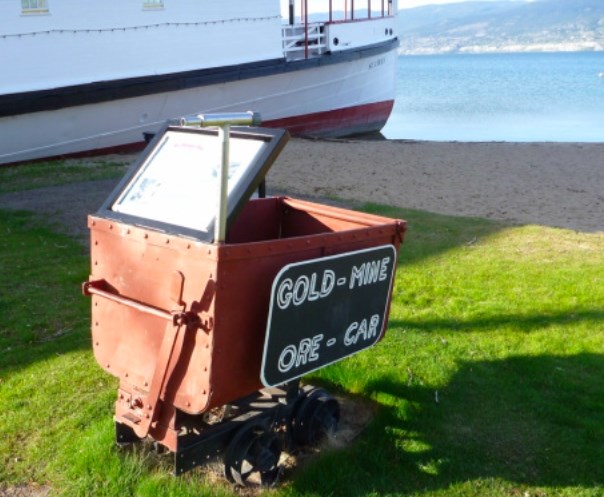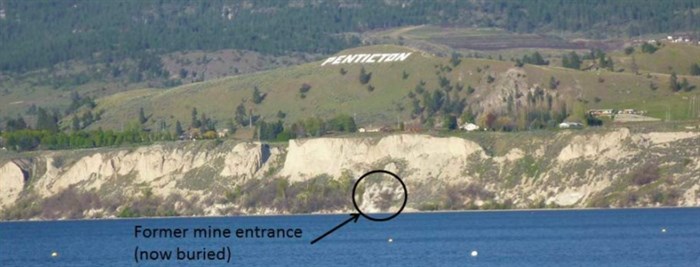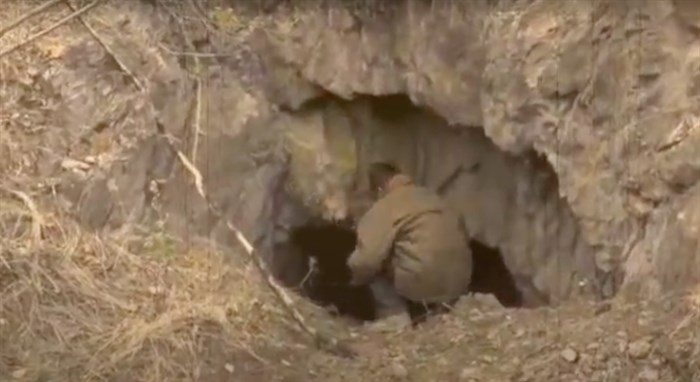
This mining cart next to the SS Sicamous is from the nearby Lakeside Mine.
Image Credit: Submitted/Okanagan Landscape
March 19, 2023 - 7:00 AM
There is an old mining cart at the SS Sicamous heritage site in Penticton with the word “Gold” boldly painted on its side.
This is not some remnant of a distant gold mine from the Cariboo or Yukon gold rushes — it’s native to Penticton itself.
It comes from the Lakeside Mine (sometimes called the Okanagan Mine, Torpedo Mine or Lakeshore Mine) that was near what is now downtown Penticton.
“From the late 1800s through to about 1952, there was a mine intermittently active at the base of Munson Mountain along the shore of Okanagan Lake,” states a report in Okanagan Landscape.
That’s an online publication created by Okanagan College instructors to “provide information about the local geology and natural history of the South Okanagan.”
An article focussing on the volcanic history of Munson Mountain on the Okanagan Landscape site, which was co-written Ryan Ransom, a professor in the physics and astronomy department at the college, references the mine.
“It is not known how the ore-bearing vein was originally located,” the report says. “The vein being mined contained antimony, gold, silver and copper and was located in a shear zone between two granite walls. It is really interesting that the mine was located in granite, while Munson Mountain above is volcanic rock. The reason for this discontinuity is the Okanagan Fault which runs through this area.”
READ MORE: These Okanagan volcanoes had a long, slow journey to the region
The article mentions the mining cart and a viewing device near the SS Sicamous that shows the closed entrance to the mine.

This shows the location of the Lakeside Mine below Munson Mountain.
Image Credit: Submitted/Okanagan Landscape
A B.C. Ministry of Energy, Mines and Petroleum Resources website says it produced small amounts of gold, silver, copper, lead and zinc but has nothing to say about its origin, just later mining efforts.
“In 1918, the shaft and lower tunnel, 27 metres below the level of the lake, were dewatered and the mine put back into operation by the Penticton Development Company,” that report says.
“That year ,122 tonnes of ore were shipped to the Greenwood and Trail smelters. The ore averaged 11.2 grams of gold per tonne, 74 grams of silver per tonne and 0.6 per cent copper. In 1934, Lakeside Mines Ltd. acquired the property and drove the upper adit to the east. During the period 1948-52 approximately 3 tonnes of ore were mined.”
Despite relatively small amounts of ore produced at that time, efforts continued to make it viable.
“In the summer of 1952, W.J. Armstrong, K. Armstrong and J. Trombley dewatered the shaft and cleaned out the workings,” the government report says. “Five tonnes of ore was mined from the lower level and shipped to the Trail smelter. In 1979, Ashnola Mining Co. Ltd. carried out 10 metres of underground channel sampling. The results of Ashnola's sampling were not filed as assessment work and are not available.”
That report details a number of shafts dug into the hillside beside the lake, including one that sloped down 30 meters and has crosscut shafts branching off.
A book called ‘British Columbia and Yukon Gold Hunters’ by Donald E. Waite, says the mine was discovered by Arthur Day in 1886.
Soon after, a syndicate of investors that included Thomas Short, the first steamboat captain on Okanagan Lake, and cattle baron Thomas Ellis, who was Penticton’s largest land owner, bought the mine.
In 1899, it says, the Vancouver and Boundary Diking and Mining Company took it over and built a wharf, bunkhouse, engine house and steam plant.
The poor quality of the ore combined with the high cost of production led to the mining being closed.
In 1934, Waite wrote, the Riverside Mining Company bought the mine and starting taking an ounce of gold a day out of it. At that time, gold was worth $15 an ounce, which was good money during the Depression.
In 1952, when the Armstrongs and J. Trombley operated the mine, CP Rail would not grant them a railway spur so they shut it down, Waite wrote.
The Lakeshore Mine was just one of many mining efforts in the Okanagan that never became large scale operations like those in the Princeton area or the Kootenays.
GLADSTONE
Further up the lake was the Gladstone Mine at Camp Hewitt, which is now Peachland.
“A shaft, commonly known as the main Gladstone shaft, was sunk by the Camp Hewitt Mining and Development Company in the late 1890s to a depth of approximately 50 metres,” the B.C. Government website says. “Development work is reported to have included 40 metres of tunneling and crosscuts on the 30 and 45 metre levels.”
Numerous other shafts were drilled.
“Despite the extensive workings, production records are limited to an 1897 notation that two small shipments of quartz containing chalcopyrite had been made to the smelter at Tacoma,” the government report says.
There was further exploratory work at the site in 1972 and 1984 but nothing came of that.

This is one of the mining shafts in the Morning Glory area.
Image Credit: YouTube/UBCO
BLUE HAWK
Further north, near Wilson’s Landing north of West Kelowna, was the Blue Hawk Mine, which is now a bit of a hiking destination.
“The Blue Hawk property was explored and operated by the Blue Hawk Syndicate during the 1930s,” the Government of B.C. website says. “Development work consisted of shallow pits, trenches and open cuts, a short shaft and three adits, totalling 180 metres, being driven to the northeast.”
In 1934, 4.5 tonnes of ore were mined, yielding gold and silver and work seems to have continued there until 1938.
READ MORE: Spiritualists, Japanese warlords and mispronounced words: Where the Okunaakan got its names
In 1967, Dawood Mines Ltd. of Kelowna bought the property and worked it for seven years, digging trenches and stripping off surface materials.
Silver, copper, mercury and gold were found but, it seems, there was no actual mining.
In 1978, Mountain Minerals Co. Ltd. looked at the uranium potential in the area.
Various companies worked the land through to 2016, taking samples and digging trenches, the government report says. While there is gold and silver in the area, there’s not enough to justify full-scale mining.
“A mere 20 minutes from the turn off from Westside Road, this abandoned gold mine is a hidden gem on Blue Grouse Mountain,” states a post on the Hiking Addiction website. “While the entire adventure is pretty short as the cave network only has two forks, expect hallway-style width and height corridors and also 0.5 feet to one-foot deep water for the first 50 feet or so of the cave. Bring rainboots if you have them.”
WHITE ELEPHANT
The White Elephant Mine was near Shorts Creek on the west side of Okanagan Lake.
“In 1921, a two-metre shaft had been completed and in 1922 about 264 tonnes of mineralized rock were shipped producing 5,257 grams of silver and 13,468 grams of gold,” the provincial government website says. “In 1924, Okanagan Premier Mines Ltd. extended the shaft to 30 metres and drove a 60-metre crosscut."
The last reference to mining at the site was in 1935.
MORNING GLORY
Further north are a series of shafts drilled by the Morning Glory Mining Company and others.
‘The Hidden Mines of the Okanagan’ is a 2012 YouTube video by UBCO student May Chapman.
She says that Albert E. Morden discovered a silver ledge in August of 1896 on Okanagan Lake’s north arm near Vernon.
In all, 14 mines were dug over 2,200 acres of land, bearing names like Evening Star, Jumbo, Daisy, Sarah and Ruby Gold, the video says.
It’s thought that the shafts are interconnected and eight were still known to be accessible at the time the video was shot, including one hole where warm air wafts up.
Gold, silver and copper were extracted from the mines, the video says.
The provincial government’s website does not reference a Morning Glory Mine or any of the others named in the video but the Vintage Vernon Facebook page, in a post about the Cameron House, notes that it was built for Morden who was a rancher and prospector and owned the Morning Glory Mine in Okanagan Landing.
To contact a reporter for this story, email Rob Munro or call 250-808-0143 or email the editor. You can also submit photos, videos or news tips to the newsroom and be entered to win a monthly prize draw.
We welcome your comments and opinions on our stories but play nice. We won't censor or delete comments unless they contain off-topic statements or links, unnecessary vulgarity, false facts, spam or obviously fake profiles. If you have any concerns about what you see in comments, email the editor in the link above.
News from © iNFOnews, 2023